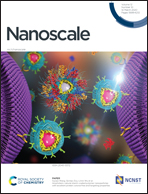Effect of a protein corona on the fibrinogen induced cellular oxidative stress of gold nanoparticles†
Abstract
The protein corona of nanoparticles is becoming a tool to understand the relation between intrinsic physicochemical properties and extrinsic biological behaviour. A diverse set of characterisation techniques such as transmission electron microscopy, mass spectrometry, dynamic light scattering, zeta-potential measurements and surface enhanced Raman spectroscopy are used to determine the composition and physical properties of the soft and hard corona formed around spherical gold nanoparticles. Advanced characterisation via small angle X-ray scattering and cryo-transmission electron microscopy suggests the presence of a thin hard corona of a few nm on 50 nm gold nanoparticles. The protein corona does not cause changes in cell viability, but inhibits the generation of reactive oxygen species in microglia cells. When a pre-incubated layer of fibrinogen, a protein with high affinity for the gold surface, is present around the nanoparticles before a protein corona is formed in bovine serum, the cellular uptake is significantly increased with an inhibition of ROS. The selective sequential pre-formation of protein complexes prior to incubation in cells is demonstrated as a viable method to alter the biological behaviour of nanoparticles.



 Please wait while we load your content...
Please wait while we load your content...